Scales are the fundamentals of any Piano Learning Course. In this Guide, we will cover Piano Scales in depth and cover all Major Scales, Minor Scales, Tones, Semi-tones, Chromatic scales briefly.
What are scales?
In music, the term scale refers to a pattern of notes ordered by pitch. Sit at the piano and find Middle C. Starting here, play all the white keys until you reach the next C. We call this pattern, the major scale.
Why play scales?
Okay, I’ll admit, scales aren’t the most exciting thing in the world to play. If you’re tempted to skip scale practice and dive right into your pieces, you’re certainly not alone! But there are many reasons why starting your practice sessions with scales is a good idea.
Firstly, have you ever tried to play the piano with cold hands? Impossible, right? Playing scales is a great way to warm up the hands, in the same way a runner will stretch his or her body before setting off on the track.
As we will see shortly, playing scales involves some technical moves such as crossing the fingers over and under each other. These are things pianists are required to do all the time in their pieces, so playing scales provides the perfect platform to practice technical elements. They are also great for improving clarity of notes, developing a controlled tone and increasing speed. (We all want to be able to play faster, right? So get practising scales!)
Finally, scales help you learn which sharps and flats belong to each key. Learning key signatures assists with chord playing, sight reading, improvisation, song writing and much more!
Scale fingering
When you played the C Major scale, you probably came across a slight issue. The scale has eight notes— but we only have five fingers! This is where finger crossing comes in.
Let’s start with an exercise to practice passing the thumb beneath the fingers. Hold out your hand with your palm facing upwards. Now try reaching your thumb across your palm to touch your little finger. This is the movement we will be making when passing the thumb as you play scales.
Before we continue, take a moment to revise the finger numbers we use when playing the piano. Remember, the thumb of each hand is finger one, moving outwards to the pinky finger, number five.
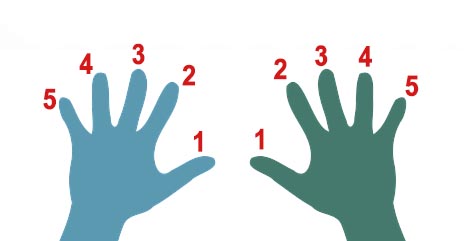
Right Hand Fingering
So let’s try the C Major scale again, this time paying attention to the fingering. We’ll start with the right hand and play a scale that moves higher up the piano. We call this an ascending scale.
Begin with your thumb on C. You’ll use your second finger to play D and finger three to play E. Now, as you reach F, cross your thumb beneath your fingers as you practiced earlier. You’ll use your thumb to play F. As your thumb crosses, let the rest of your fingers move so you return to a curved hand shape. You’ll use your second finger to play G, finger three to play A, four for B and your fifth finger for the top C. See how we can now play the whole scale without lifting your hand from the keyboard?
Let’s try coming down the scale. This is called descending.
The fingering for the descending scale will remain the same— just in reverse. You’ll begin with your fifth finger on high C and use every finger until your thumb reaches F. Now, cross your third (middle) finger over your thumb to play E. Let the hands return to a curved position and finish the scale using your second finger to play D and your thumb to return to Middle C.
Left Hand Fingering
To play the ascending scale in the left hand, begin with your fifth finger on the C below Middle C. Play one note with each finger until you reach G with your thumb. Now, just as you did with the right hand, cross your third finger over the thumb to play A and bring your hand back to a curved position. Use your second finger to play B and your thumb to play Middle C; now the top note of the scale. Reverse this fingering to descend. Can you see the similarities between the left and right hand fingering?

Something more challenging
Once you can comfortably play C Major scale with both hands, it’s time to try something a little more challenging.
This time, start your scale on G. Use your thumb if you’re playing with the right hand, or the fifth finger if you are using the left. Use the same fingering you did to play C Major. This time, instead of playing all white notes, raise F to F#.

Sounds pretty similar to C Major, right? This is because of the pattern of tones and semitones.
Tones and Semitones
The terms tone (or whole tone) and semitone refer to the distance between two notes. A semitone is the distance between two notes directly beside each other on the piano. For example, C to C# is a semitone, as is Eb to E, as is E to F.
A tone is simply two semitones. C to D is a tone, as is G# to A#, as is Eb to F.
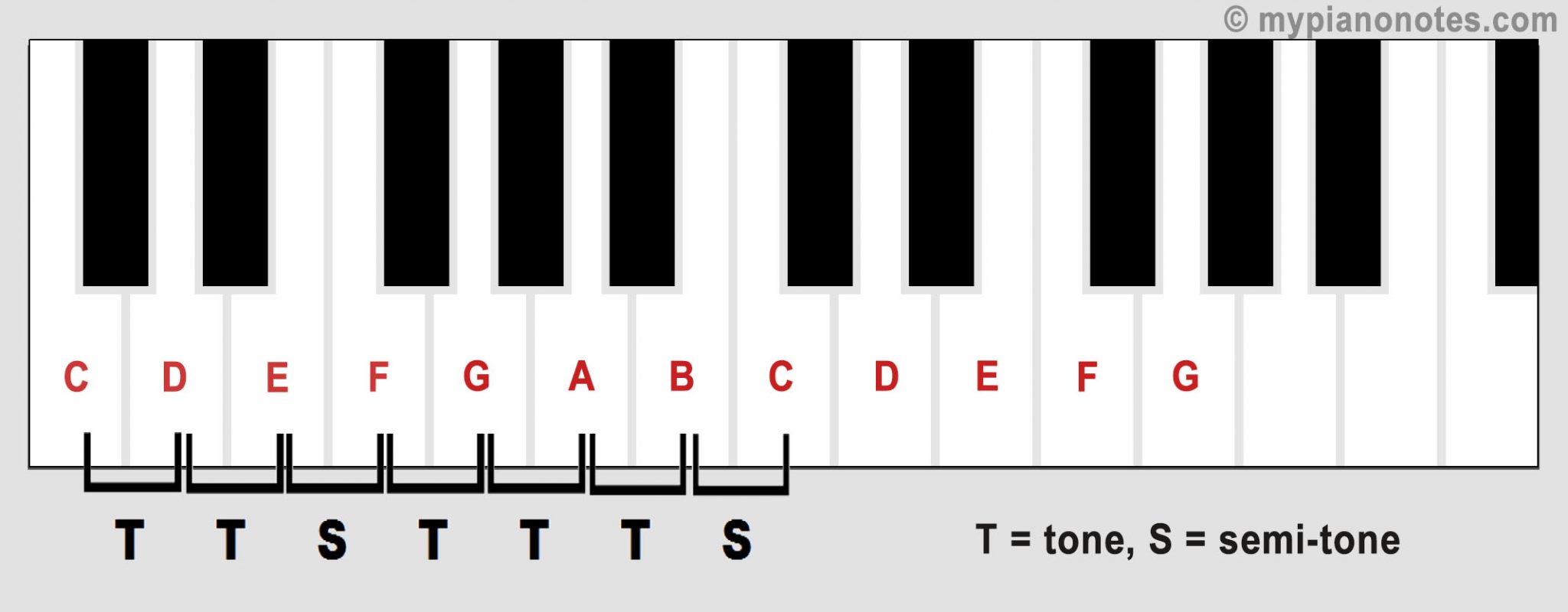
All major scales sound similar because they have the same pattern of tones and semitones. Take a look at the diagram below. The first step of the major scale is a tone, followed by another tone, then a semitone. The pattern continues; tone, tone, tone, semitone.
Other major scales:
We can build a major scale starting on any note of the octave. Each scale will have a different pattern of sharps or flats in order to keep that major scale pattern of tone-tone-semitone-tone-tone-tone-semitone.
Major scales with sharps:
Here are the major scales with sharps in their key signature:
- G Major: G A B C D E F# G
- D Major: D E F# G A B C# D
- A Major: A B C# D E F# G# A
- E Major: E F# G# A B C# D# E
- B Major: B C# D# E F# G# A# B
- F# Major: F# G# A# B C# D# E# F#
Major Scales with flats:
And the major scales with flats:
- F Major: F G A Bb C D E F
- Bb Major: Bb C D Eb F G A Bb
- Eb Major: Eb F G Ab Bb C D Eb
- Ab Major: Ab Bb C Db Eb F G Ab
- Db Major: Db Eb F Gb Ab Bb C Db
Of course, you’ve memorized the tone and semitone pattern and worked all these scales out by yourself, right?!
Fingering these scales:
Because of their varying patterns of black keys, we need to alter our fingering as we play new scales. This is largely because it’s best to avoid playing black keys with finger one— not only is it super awkward to play those thin keys with the side of your thumb, it’s also a struggle to control the sound. Click the links above to see the recommended fingering for some of these scales.
Minor Scales
Let’s now move away from major keys to the eerie sounding minor scales. Unlike their major counterparts, minor scales can be played in three forms: natural minor, harmonic minor and melodic minor, each with a slightly different pattern of tones and semitones.
Natural Minors
We’ll start with the easiest of the three forms; the natural minor.
Each of the major scales we’ve learned has a minor scale with the same key signature. We call this the relative minor.
To find the relative minor of a key, move down three semitones.
Let’s try it with the easiest of the major scales: C Major. Stepping three semitones down will bring you to A.
Using the same fingering as for C Major, play all the white keys beginning and ending on A. This is called A Natural Minor scale. Notice how we are using the same eight notes as for C Major, but by starting and ending in a different place, we have changed the pattern of tones and semitones. Play it again, listening to the huge difference in sound this makes!
Can you work out the pattern of tones and semitones for the natural minor scale?
Here it is:
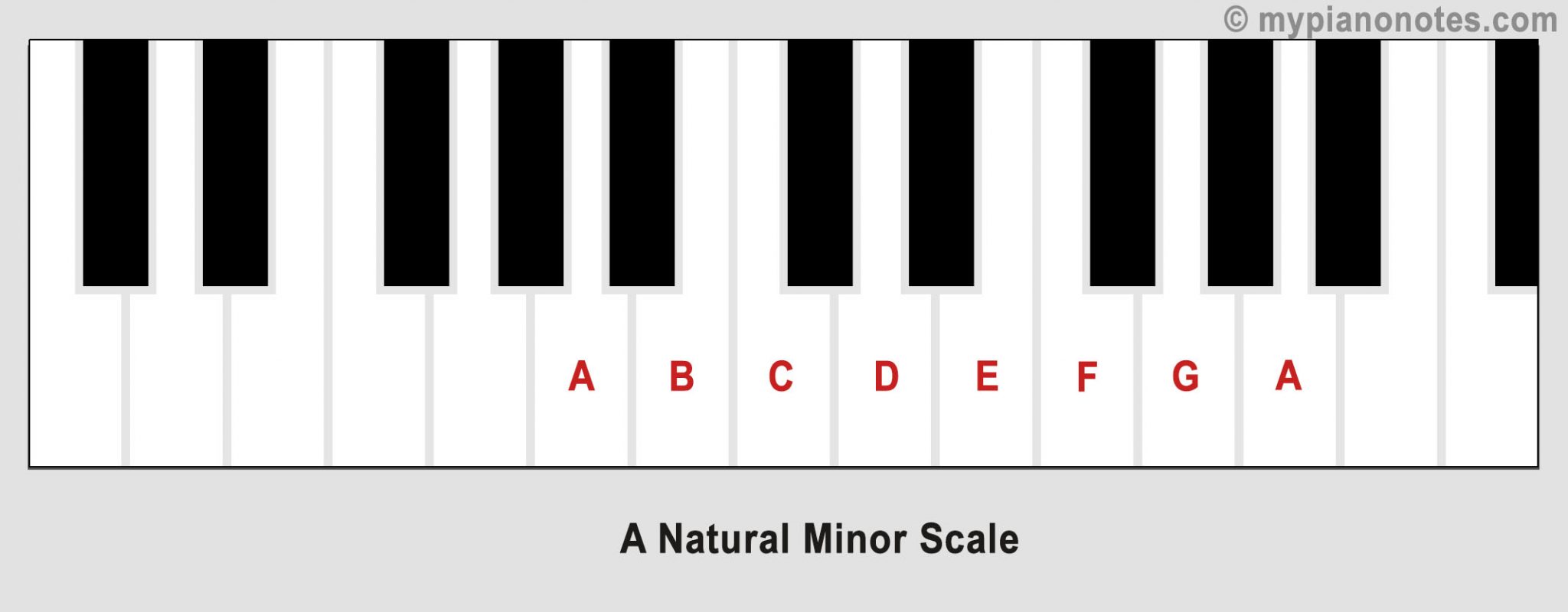
Natural Minor Scales with Sharps:
Here are the natural minor scales with sharps in their key signatures.
- E Natural Minor: E F# G A B C D E (Relative minor of G Major)
- B Natural Minor: B C# D E F# G A B (Relative minor of D Major)
- F# Natural Minor: F# G# A B C# D E F# (Relative minor of A Major)
- C# Natural Minor: C# D# E F# G# A B C# (Relative minor of D Major)
- G# Natural Minor: G# A# B C# D# E F# G# (Relative minor of B Major)
Natural Minor Scales with Flats:
And the natural minor scales with flats:
- D Natural Minor: D E F G A Bb C D (Relative minor of F Major)
- G Natural Minor: G A Bb C D Eb F G (Relative of Bb Major)
- C Natural Minor: C D Eb F G Ab Bb C (Relative of Eb Major)
- F Natural Minor: F G Ab Bb C Db Eb F (Relative of Ab Major)
- Bb Natural Minor: Bb C Db Eb F Gb Ab Bb (Relative of Bb Major)
- Eb Natural Minor: Eb F Gb Ab Bb Cb Db Eb (Relative major of Gb/F# Major)
Click the links above to see the recommended fingering for these minor scales.
Altering the Natural Minor Scale:
In the classical piano repertoire, the harmonic and melodic forms of the minor scale are far more common than the natural minor. So let’s take a look.
Harmonic Minor
To turn a natural minor into its harmonic version, we simply raise the seventh note by a semitone. Let’s try it with A Minor. If A is the first note of the scale, which note is the seventh? You got it. It’s G. In the harmonic minor scale, this becomes G#.
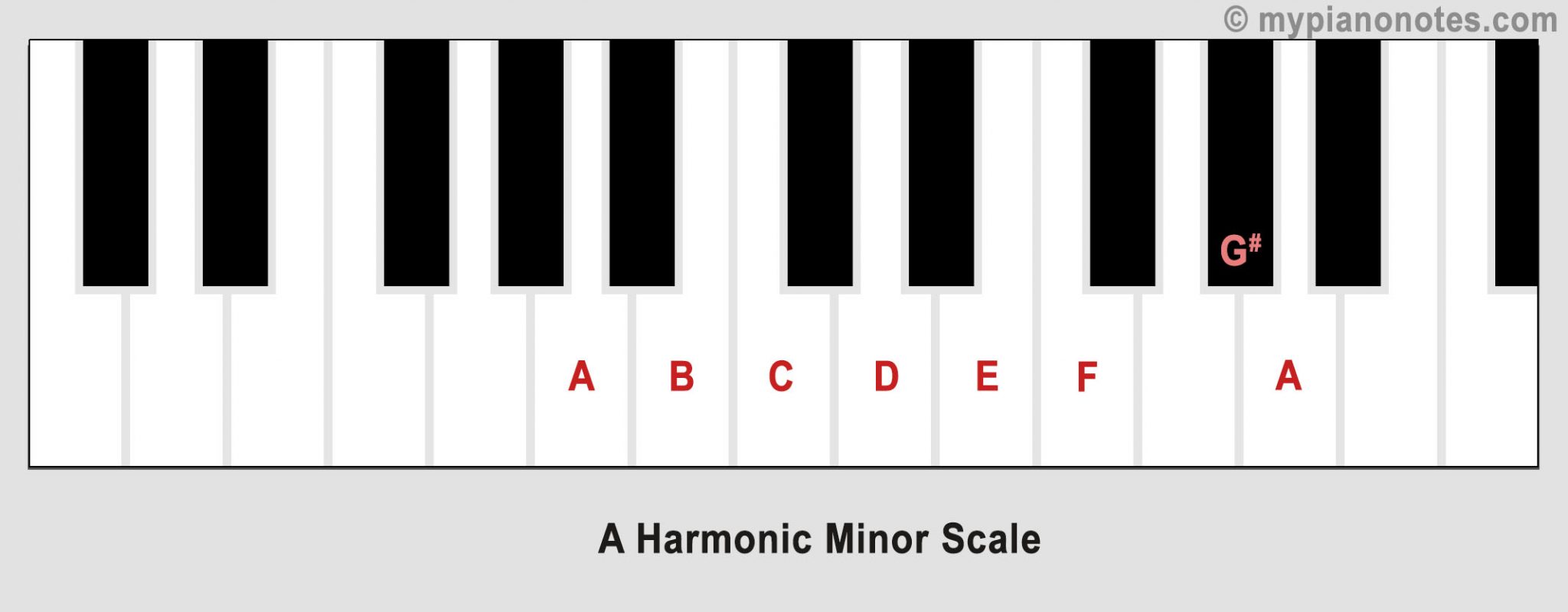
Play A Minor again, this time with the raised seventh (G#). Notice the jump of three semitones between F and G#. This is called an augmented second. Listen to the exotic, Egyptian sound of the harmonic minor.
By raising the seventh note, we create a semitone step between the last two notes of the scale. This creates a strong pull towards the top note of the scale or what we call the tonic.
When you’ve mastered A harmonic minor, try altering some of the other natural minors to their harmonic form. Just raise the seventh note by a semitone each time.
Melodic Minor Scales
The melodic minor scale is slightly more complex in that it uses different notes in its ascending and descending versions.
Let’s start again with A Natural Minor.
To form the ascending melodic version, raise both the sixth and seventh notes by a semitone. F becomes F# and G becomes G#.
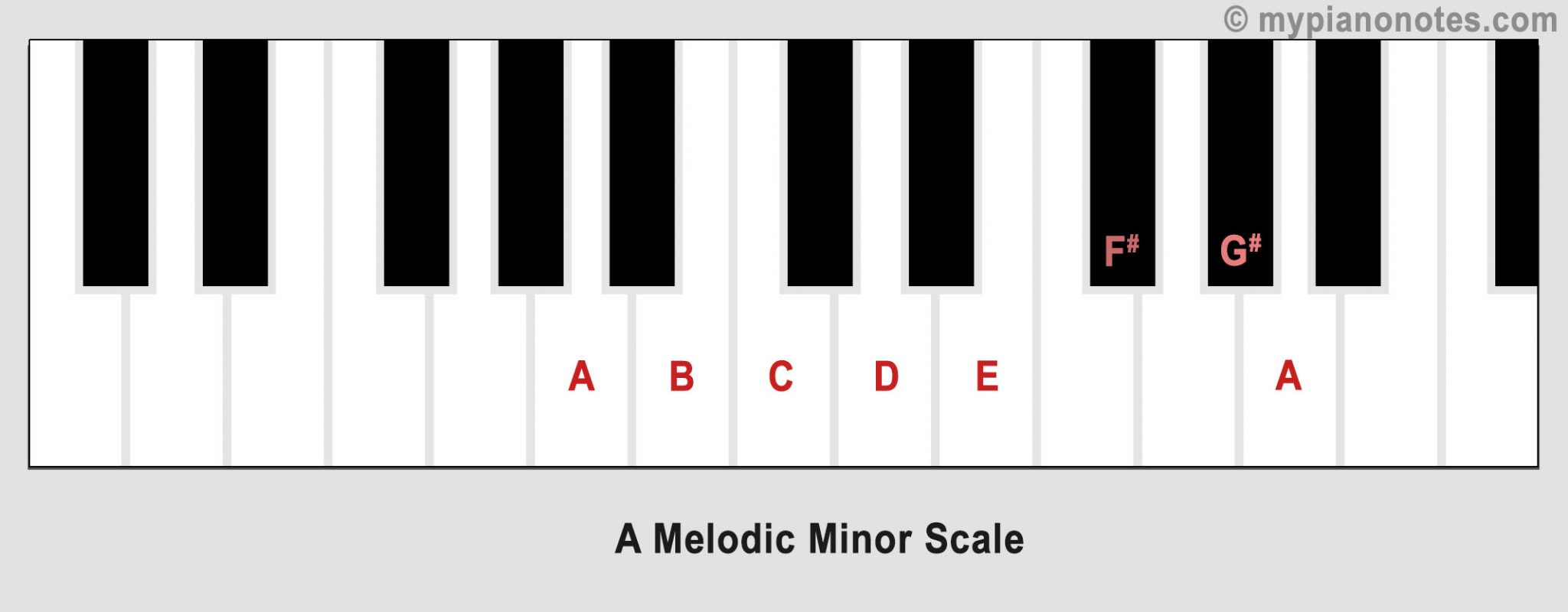
To play the descending melodic minor, we simply lower the sixth and seventh notes back to their original position. F# becomes F and G# becomes G. Notice anything? You’re right— the descending melodic minor scale is exactly the same as the natural minor.
Note that the fingering of the minor scales will remain the same, no matter which form you’re using. (Good news, right?)
Chromatic Scales
Let’s take a look at one final scale you can add to your practice routine.
The chromatic scale is constructed entirely of semitones. It has no key signature and can be started on any note.
Here are the notes of C Chromatic Scale:
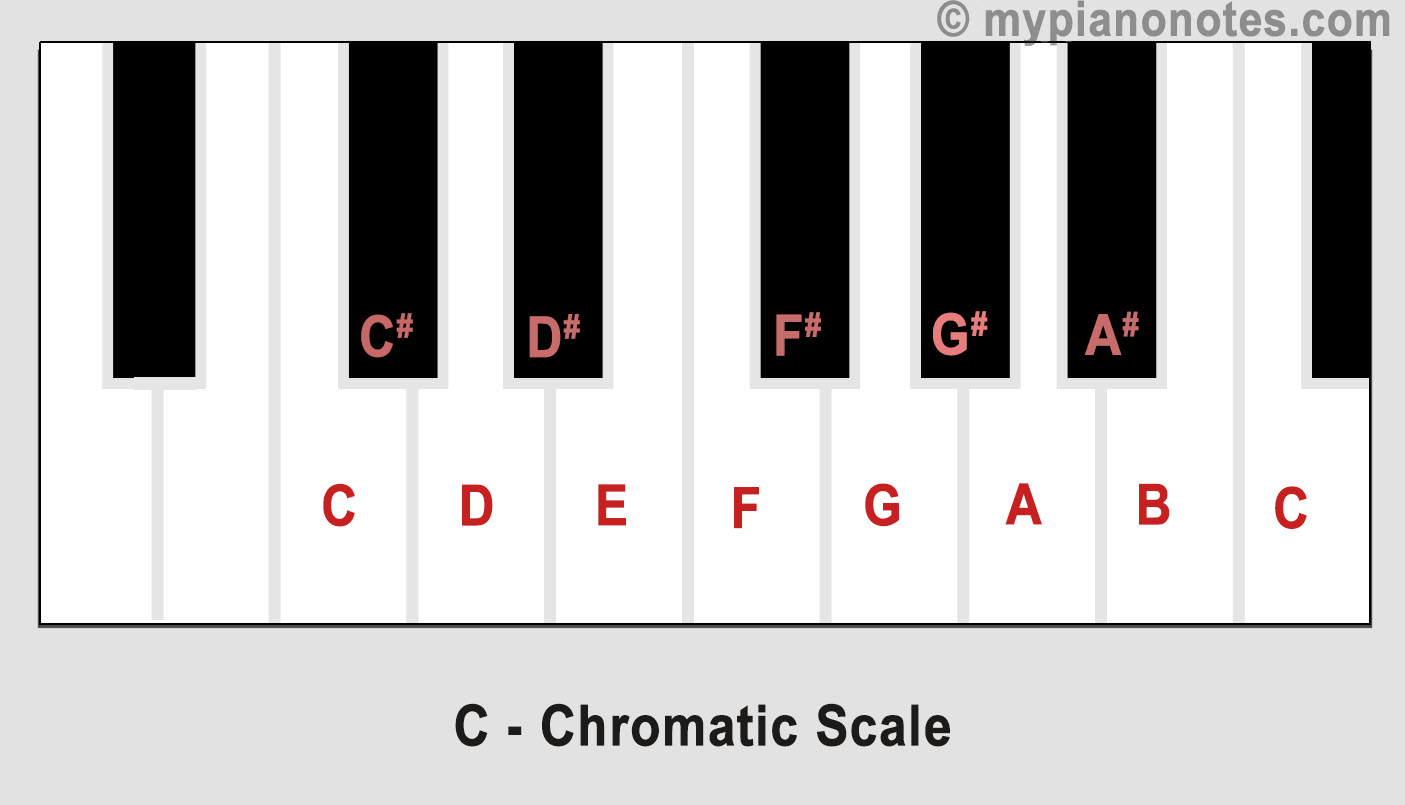
That’s right, it’s simply every note of the octave.
To finger the scale, use fingers one, two and three only:
Creating a Scale Practice Program:
So here you have what is no doubt an overwhelming amount of scales to learn! While memorization of all the above patterns is a great long-term goal for any serious pianist, adding even just one or two scales to your practice program will see your technique and dexterity improve noticeably in a short amount of time.
A great way to build your scale practice program is to begin with C Major/A Minor and gradually add scales with increasingly difficult key signatures.
You can also choose to practice the scales that correspond to the keys of the piece you are about to play. For example, if your piece has one sharp in its key signature, warm up by playing G Major and E Minor scales. This is a fantastic way to get the notes of the piece beneath your fingers.
Above all, be patient. Aim for clarity and accuracy of both notes and fingering. Remember, just like when learning a piece, speed comes last!
Good luck!
- Genda Phool - May 27, 2020
- Qismat - May 27, 2020
- Naagin (Aashta Gill) - May 24, 2020





